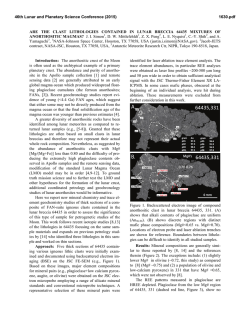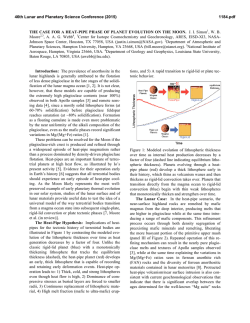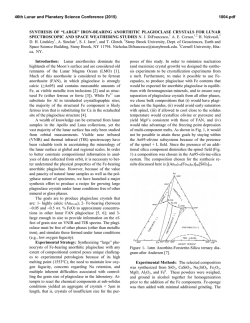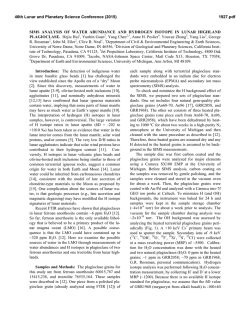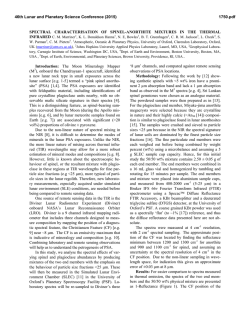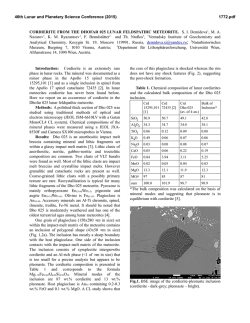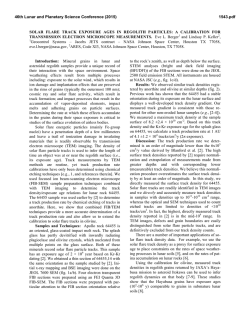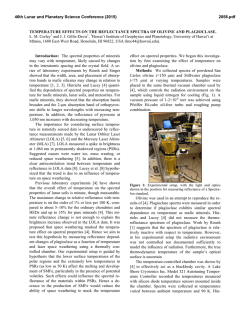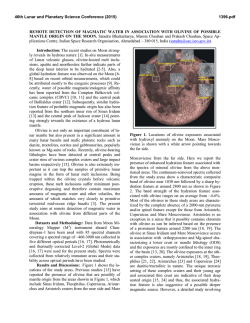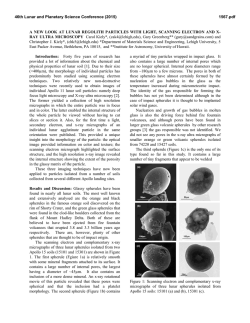
CHARACTERISATION OF MIYAKE-JIMA ANORTHITE AS A LUNAR
46th Lunar and Planetary Science Conference (2015) 1251.pdf CHARACTERISATION OF MIYAKE-JIMA ANORTHITE AS A LUNAR ANALOGUE. T. F. V. Brydges1, C. M. Marriner1, K. L. Donaldson Hanna1, N. E. Bowles1, and R. MacDonald1, 1Atmospheric, Oceanic and Planetary Physics, University of Oxford, Clarendon Laboratory, Oxford, UK ([email protected]). Introduction: It is hypothesised that the lunar anorthositic highlands, rocks containing >90% plagioclase, formed by the crystallisation and accumulation of Ca-rich plagioclase at the top of a large scale lunar magma ocean [e.g. 1-3]. The first evidence of the anorthositic highlands came in the form of a specific rock type, the ferroan anorthosite (FAN), which was distributed among samples returned from the Apollo landing sites [e.g. 2]. The FANs have distinct characteristics which uniquely identify them from other pristine rock samples (e.g. Mg- and Alkali-suite rocks). The plagioclase in FANs are Ca-rich (anorthite in composition) and have a small compositional range (An94-98) while the mafic components found in association with plagioclase are Fe-rich (ferroan) relative to the mafic components of other lunar rocks [e.g. 3-4]. Recent high spatial and high spectral measurements of the Moon by the SELENE and Chandrayaan-1 spacecraft have unambiguously identified regions of spectrally pure, crystalline anorthosite across the lunar surface based on plagioclase’s unique absorption band at 1.25µm owing to minor amounts of Fe2+ in the crystal structure [e.g. 5-8]. In support of the recent visibleto near-infrared (VNIR) observations of the Moon, a detailed laboratory study of plagioclase-dominated mineral mixtures was conducted to demonstrate the spectral effects of varying mafic and oxide composition and abundance in mixtures with a common plagioclase endmember [9]. Results indicate that: (1) plagioclase can be a significant contributor to VNIR spectra when strongly absorbing minerals are present in low abundance and (2) due to the transparent nature of plagioclase, <90% plagioclase can be spectrally hidden in regions where pyroxene, olivine and spinel dominate the spectral signature [9]. However, the common plagioclase end member used in this study was labradorite in composition (An59), which is more Na-rich than plagioclase found in FANs and most Mg-suite rocks. In this work, we characterise a terrestrial anorthite sample from the Miyake-jima volcano in an effort to demonstrate its utility as a compositional and spectral analogue to plagioclase found in FANs. Ejecta from the Miyake-jima volcano in Japan contains basalt coated anorthite and olivine megacrysts, with most of the plagioclase megacrysts appearing to have clear, homogeneous cores [10]. We first separated the anorthite megacrysts from their basaltic coating and olivine inclusions by grinding the samples down, and then analysed anorthite particles using a scanning electron microscope (SEM) to investigate its composition. Finally, NIR reflectance measurements were made to confirm (1) the presence of a diagnostic absorption band at 1.25µm and (2) the purity of the anorthite sample. Sample Preparation and Characterisation: Particulates <75µm are not easily separated by the Frantz isodynamic magnetic separator, and so a pestle and mortar was required which was harder than anorthite (hardness of ~6 on the Mohs Scale), yet not so hard as to grind a significant amount of sample down to <75µm. For this reason, an agate pestle and mortar was chosen as it satisfied both these requirements, having a hardness of ~6.5-7. Some of the larger anorthite particles were chosen and placed in grain mounts to characterise the average mineral chemistry using the JEOL JSM-840A SEM with Energy-Dispersive X-ray (EDX) Spectroscopy in the University of Oxford’s Department of Earth Sciences (see figure 1). Figure 1. SEM image of Miyake-jima anorthite particles. Yellow circle approximates SEM spot size used in analysis. Table 1. Average mineral chemistry of Miyake-jima anorthite megacrysts taken from ~10 locations across 5 anorthite particles. The remaining particles were sieved to separate them into size fractions of <75µm, 75-125µm and 125250µm. Particulates in the 75-125µm and 125-250µm size fractions were then prepared for magnetic separation. The 75-125µm and 125-250µm size separates were chosen as the particles are small enough that they were almost fully separated into distinct minerals, yet not so small that the Frantz magnetic separator would not be effective at separating them. The particle size separates were first washed to remove any fine particles clinging to the larger particles, which would cause separation problems in the magnetic separator. Small portions of the 75-125µm particle size fraction were placed in the 75µm sieve, and the 125-250µm particle 46th Lunar and Planetary Science Conference (2015) size fraction in the 125µm sieve. The grains were then liberally washed in each sieve by repeatedly pouring distilled water over them. The sieves were then put in the oven at 353K until dry. This step was repeated three times. Once washed, the particles were put into clean vials to keep each particle size separate, and run through the Frantz magnetic separator at the University of Oxford’s Department of Earth Sciences. The Frantz uses magnetic fields to separate particles into magnetic and non-magnetic fractions. Each set of particle size separates were run through the Frantz until only anorthite particles remained in the non-magnetic fraction, as observed through a microscope. Once magnetically separated, reflectance measurements were made on the 75-125µm and 125-250µm particle size fractions across NIR wavelengths using a Brüker IFS 66v Fourier Transform Infrared (FTIR) spectrometer with a SpecacTM Diffuse Reflectance FTIR Accessory, a CaF2 beamsplitter and a deuterated triglycine sulfate (DTGS) detector at the University of Oxford’s Planetary Spectroscopy Facility. The measurements were taken with a 12 mm aperture and a 2.2 kHz scanner velocity. These measurements were used to confirm 1) the presence of plagioclase’s diagnostic absorption band near 1.25µm and 2) all mafic materials had been effectively removed from the anorthite megacrysts (see figure 2). Figure 2. Reflectance measurements of the 125250µm particle size fraction. Note the diagnostic absorption band near 1.25µm indicative of crystalline plagioclase. Results: The SEM analysis of the anorthite particles confirm the high Ca nature of the plagioclase (see table 1). SEM analyses are useful for detecting abundant elements, however, it is less reliable with trace elements, which is reflected in the table as the trace 1251.pdf elements have much higher percentage errors in comparison to the abundant elements. The NIR reflectance measurements confirm the crystalline nature of the anorthite as it has a distinct absorption band near 1.25µm (see figure 2). In addition, the spectral measurements demonstrate that the basaltic coating and olivine inclusions have effectively been removed from the anorthite megacrysts as no diagnostic absorption bands are observed near 1 and 2µm, which would indicate the presence of even minor amounts of mafic materials. Ongoing and Future Work: To best demonstrate the utility of the Miyake-jima anorthite as a lunar analogue we will conduct electron microprobe (EMP) analysis at the University of Oxford to confirm the Carich (high An #) nature of the Miyake-jima anorthites. Future work will also focus on making mixtures of Miyake-jima anorthite with varying mafic and oxide mineral end members as minerals rarely occur in isolation on a planetary surface, typically being mixed on a variety of spatial scales, occurring together in a range of rock types and soils [9]. The anorthite will be further ground down into a <25µm particle size fraction and will first be used in mixtures with spinel, and then other mafic minerals such as olivine and pyroxene [11]. These physical mixtures will then be measured under simulated lunar conditions in the Simulated Lunar Environment Chamber at the University of Oxford [12] to characterise the spectral effects of mineral mixtures across thermal infrared wavelengths under lunarlike conditions. In addition, laboratory measurements of mineral mixtures will be compared to thermal infrared observations of the lunar surface by the Diviner Lunar Radiometer Experiment on board NASA’s Lunar Reconnaissance Orbiter to better constrain lunar surface compositions, in particular the ratio of plagioclase to mafic or oxide minerals in regions of interest. References: [1] Smith J.V. et al. (1970) Geology, 78, 381-405. [2] Wood J.A. et al. (1970) Proc. Apollo 11 Lunar Sci Conf., 1, 965-988. [3] Warren P.H. (1985) Ann. Rev. Earth Planet. Sci., 13, 201-240. [4] Dowty E. et.al. (1974) Earth Planet. Sci. Lett., 24, 1525. [5] Ohtake M. et. al. (2009) Nature, 461, doi:10.1038/nature08317. [6] Yamamoto S. et. al. (2012) Geophys. Res. Lett., 39, doi: 10.1029/2012GL052098. [7] Cheek L.C. et. al. (2013) JGR, 118, doi:10.1002/jgre.20126. [8] Donaldson Hanna K.L. et. al. (2014) JGR, 119, doi:10.1002/2013JE004476. [9] Cheek L.C. and Pieters C.M. (2014) Am. Mineral, 99, 1871-1892. [10] Amma-Miyaska M. and Nakagawa M. (2002) J. Volcanol. Geotherm. Res., 117, 263-283. [11] Marriner C. M. et al. (2015) LPS XXXXVI. [12] Thomas I.R. et al., (2012) Rev. Sci. Instrum., 83(12), 124502
© Copyright 2025
